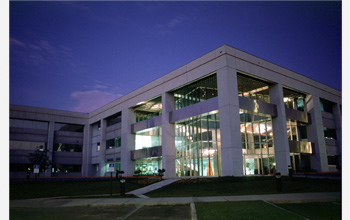News Release 10-098
Bigger Spectrometer to Study Life's Smaller Nuts and Bolts
NSF to build one of world's most powerful mass spectrometers to study biology, fuels

The National High Magnetic Field Laboratory headquarters in Tallahassee, Fla., is shown at night.
June 15, 2010
This material is available primarily for archival purposes. Telephone numbers or other contact information may be out of date; please see current contact information at media contacts.
Florida State University is planning to build one of the world's most powerful mass spectrometers. The ultrahigh-field mass spectrometer, newly funded by the National Science Foundation, will allow researchers to study in ever greater detail proteins and other molecules--the nuts and bolts of biology, the environment and renewable energy--and push the boundaries of such analyses.
NSF's Division of Chemistry has dedicated $17.5 million ($15 million of this is out of American Recovery and Reinvestment Act funding) to the National High Magnetic Field Laboratory at FSU. The facility will build a high-field mass spectrometer over the next four to five years.
"This grant will give us the opportunity to see the chemical and molecular world in unprecedented detail--sort of like HDTV compared to ordinary TV," said Alan Marshall, director of NHMFL's Ion Cyclotron Resonance Program.
This mass spectrometer will provide a quantum leap in resolution and accuracy over current state-of-the-art instruments. Officially known as a Fourier transform ion cyclotron resonance mass spectrometer (FT-ICR MS), the instrument's key job is to resolve, identify and count molecules such as proteins or chemicals in biological systems--for example, bacteria and other micro-organisms that can be used to create alternative fuel sources or clean up the environment.
That high definition will let scientists zoom in on and identify whole proteins--the workhorses of cells--and other molecules, such as fats that work alongside them. Currently, researchers have to break down proteins to identify them, using mass spectrometers. Being able to examine them whole will reveal how and when proteins are turned off and on during the life cycle of a cell, or reveal the parts of proteins that touch when they work together.
The instrument will also be able to identify the variety of molecules that make up fossil fuels. Knowing the complement of molecules in crude oil will help researchers "grow" synthetic fuels with micro-organisms such as algae in an environmentally sustainable way, and an ultrahigh-field mass spectrometer will help researchers study and improve the process from start to finish.
Florida's NHMFL is a user facility that a national and international cadre of scientists can visit to use this unique instrument.
In a series of workshops that involved mass spectrometrists and representatives from the broader research community, researchers with NHMFL identified the ultrahigh-field mass spectrometers as the next step needed to address fundamental scientific challenges in a variety of fields.
"The Chemistry Division at NSF is very excited about this unique and potentially transformative project, which would not have been possible to fund without the availability of Recovery Act funds," said Luis Echegoyen, director of NSF's Division of Chemistry.
FSU NHMFL has received its first year of funding for this project.
--
The only facility of its kind in the United States (http://www.magnet.fsu.edu ), the National High Magnetic Field Laboratory is the largest and highest-powered magnet laboratory in the world, headquartered in a 370,000-square-foot complex near Florida State University in Tallahassee. The lab also includes sites at the Los Alamos National Laboratory in New Mexico and the University of Florida in Gainesville. Together these three institutions operate the lab, collaborating in a unique, interdisciplinary way to advance basic science, engineering and technology in the 21st century. Its mission, as set forth by the National Science Foundation: "To provide the highest magnetic fields and necessary services for scientific research conducted by users from a wide range of disciplines, including physics, chemistry, materials science, engineering, biology and geology."
-NSF-
Media Contacts
Maria C. Zacharias, NSF, (703) 292-8454, email: mzachari@nsf.gov
Susan Ray, National High Magnetic Field Laboratory, (850) 644-9651, email: sray@magnet.fsu.edu
The U.S. National Science Foundation propels the nation forward by advancing fundamental research in all fields of science and engineering. NSF supports research and people by providing facilities, instruments and funding to support their ingenuity and sustain the U.S. as a global leader in research and innovation. With a fiscal year 2023 budget of $9.5 billion, NSF funds reach all 50 states through grants to nearly 2,000 colleges, universities and institutions. Each year, NSF receives more than 40,000 competitive proposals and makes about 11,000 new awards. Those awards include support for cooperative research with industry, Arctic and Antarctic research and operations, and U.S. participation in international scientific efforts.
Connect with us online
NSF website: nsf.gov
NSF News: nsf.gov/news
For News Media: nsf.gov/news/newsroom
Statistics: nsf.gov/statistics/
Awards database: nsf.gov/awardsearch/
Follow us on social
Twitter: twitter.com/NSF
Facebook: facebook.com/US.NSF
Instagram: instagram.com/nsfgov
